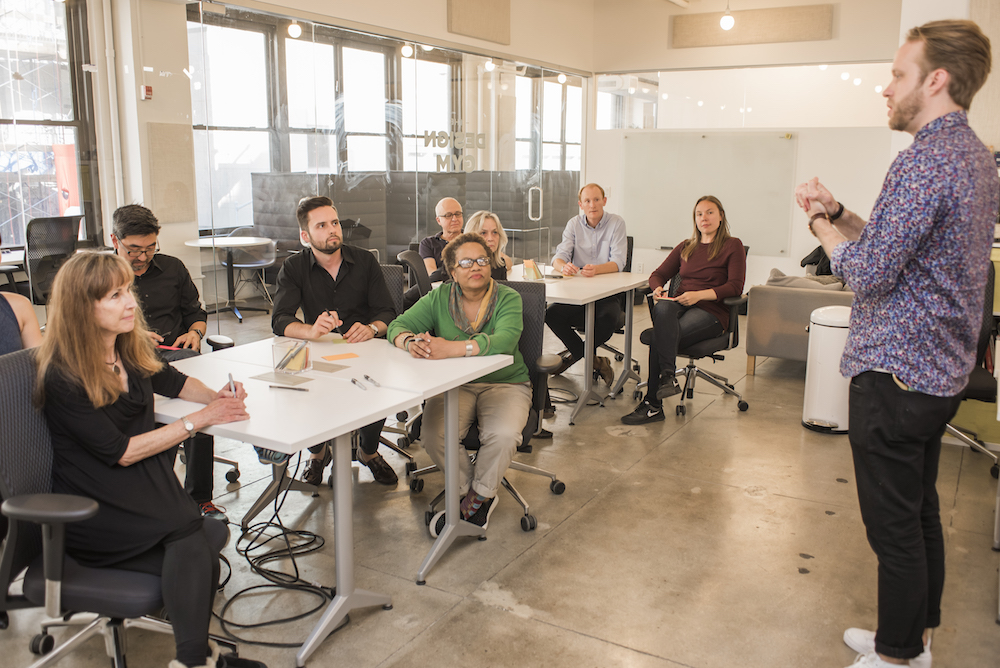Andy Hagerman, BBA ’08, asks big questions. As the co-founder of the Design Gym—a New York City based company that offers public workshops and consulting services aiming to boost organizational creativity, leadership, and collaboration through design thinking pedagogy—it’s his job to ask big questions.
“How do we get people excited about their work again?” asks Hagerman, who studied marketing and international business at the Fox School. “How do you translate people’s real emotions and behaviors into real things of impact, and products and services that create value in their lives, not just value in the company?”
Hagerman, however, doesn’t merely ask questions. He gets students and clients—which, since the company launched in 2012, have included Etsy, LinkedIn, Facebook, Porsche, the New York City Department of Education, and the Rockefeller Foundation—to ask them. And, most importantly, Hagerman and the Design Gym provide design thinking tools to answer those questions in exhilarating and beneficial ways that help deepen relationships with collaborators and customers.
“More diverse collaboration has the impact to change the world,” says Hagerman about the Design Gym’s ideals and objectives. “It’s an imperative way that businesses are working now. We want businesses to develop more empathetic, human-centered relationships with customers and to foster creative leadership. We want to give people the tools, confidence, and language to be able to raise their hand if they think work can be done better. If they see things that are broken, or things being done just because that’s the way they’ve always been done, we want to help people feel confident to change that.”
To learn more about the work the Design Gym does, we asked Hagerman to share with us some insights on the five phases of design thinking and how it can benefit students, clients, and businesses.
1. Interact Directly with Your Customers

“When people solve problems, they want to move as fast as possible; it’s all about efficiency. Design thinking builds a few more steps into problem solving that don’t necessarily slow things down, but make us think more divergently than normal. Instead of identifying a problem and picking a solution quickly, it forces us to ask questions. Who are the users? What is their challenge? Who will be using the solution? How do we build empathy with the users and customers of the work we’re doing? How can we learn more about them? Most people don’t have time for deep ethnographic research or interviewing customers, but you can block a half day off your work cycle to go out and find inspiration. Go to the places where your customers hangout, go to the stores your customers go to, talk to the people they talk to, take them out to coffee and talk to them. A little inspiration and empathy gets you out of your normal ways of thinking about your customer.”
2. Reframe Your Problem—Then Get Creative
“Once you have this great data combined with research, you synthesize it into insights. This is where design thinking meets strategic thinking. Based on what we’ve learned and accomplished, how can we reframe the challenge to solve the right problem? Once you talk to your customers, you can better see and solve the problem through their eyes. And you’ll get more creative.”
3. Move Beyond Obvious Solutions
“Once you have a new way to see your challenge, the impetus is to push yourself beyond the obvious solutions. Many times, when we have a challenge, a few ideas pop into our heads immediately, but they’re usually the obvious ones. Based on time, that’s what we run with. This phase is about finding more creative solutions so here we teach new tools to help people do that. One is called ‘lateral inspiration,’ which is about looking outside your industry at how other companies solve for similar customer or business needs. If you’re a bank, how can you look to the entertainment industry or the tech world to see how they’re addressing similar needs? What would it look like if we tried to solve that problem in a similar way that is authentic to us?”
4. Experiment—and Abandon the Illusion of Perfection
“This is all about rapid prototyping and bringing ideas to life in low-fidelity ways. The focus isn’t on building, but learning. The first version of an idea is almost never going to be the best or the perfect one, but the sooner we get it in front of people to get feedback, the sooner we can improve it. One activity we do is encourage the team, and when you ask them to build something, ask for the 40 percent version, and tell them to do it in 45 minutes. Set false constraints that are impossible. You’ll never create the best version, but as a creative leader you should ask for something concrete quickly so people can respond. It’s better for the creativity of the team and the finished product.”
5. Create Audience-Specific Narratives
“This phase is about telling a compelling story that will get buy-in and action. We encourage people to go back and put those empathy goggles on and think about the other project stakeholders. If you’re pitching the operations department, they’re probably thinking about logistics and cost, so you need to tell a story rooted in those things. If you’re pitching a senior executive, they may be concerned about sustainability and ROI—so how do you tell that story? We encourage people to use a storyboard for this, and create that comic book level version of how a new service or product may show up in your customers or stakeholders life.”

